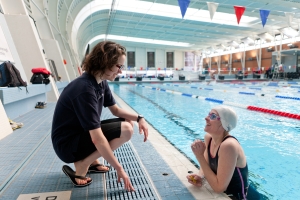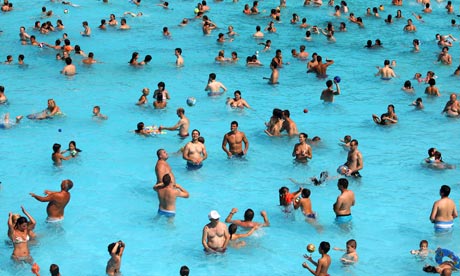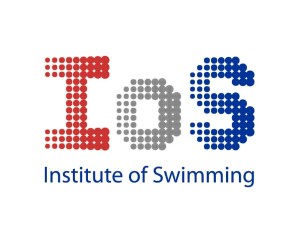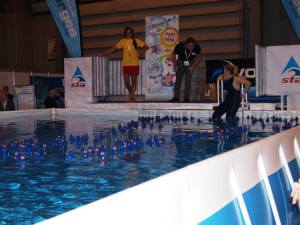 Guest Blog from RAPs member Lucy Lloyd-Roach
Guest Blog from RAPs member Lucy Lloyd-Roach
In my last blog you may remember I described some of the benefits that water aerobics can bring, I’d now like to share with you a few of the anecdotes that people have told me so far. I hope you’ll find them as amazing as I have.
Pat, swims once or twice a week and attends 2 water aerobic sessions a week
30 years ago I broke my back in 3 places. Before starting water aerobics I would say that I only recovered to about 20% of my pre-accident state. I lived with severe back pain all the time. I could only walk for about 20 yards before I’d be in absolute agony and I couldn’t straighten my back.
In August 2012, a group of friends decided to try a swimming and water aerobics class. I went to be sociable. I couldn’t imagine that when I started, that it would change my life!
From doing hardly any exercise I have built up to 3-4 hours a week and feel I have recovered about 90% from the accident. My posture (sitting and standing) has improved; I can now stand straight, move around more easily and can now walk for 30 minutes without being in pain. I recently had to take time out and I noticed the difference– I was in pain and looked forward to going again so I could be pain free.
My outlook is now positive instead of negative (if like me, you’re living with pain, you’ll know just how much it takes over your life). I have more energy, am happier and feel better within myself.
Anne-Marie, 35, attends once a week.
I suffered back and leg pain for around 7 years.
I was diagnosed with right sided L4/5 disc prolapse with bilateral L5/S1 prolapses. The pain was debilitating and I was on strong medication. I had tried everything for it from epilepsy drugs to block nerve pain to painkillers (codeine, tramadol but then I became allergic to both so stopped taking them and had to live in pain).
My doctor suggested swimming and I discovered water aerobics and it’s changed my life!
In September 2012 I had microdiscectomy surgery. I went to water aerobics for about 6-8 weeks before surgery and my surgeon said that I had a fast recovery due to my strengthened core muscles and back! The surgeon was amazed how quickly I was back on my feet and back to work; it’s got to be down to the water aerobics!
Water aerobics has definitely improved the quality of my life in a number of ways. I’m healthier than I have been in years. I’m a single Mum to a 10 year old daughter and I am able to do more with her now. My mobility has significantly improved and it’s helped to maintain my weight. I don’t take any medication whatsoever and my posture is much better. If I miss a session my back aches badly but when I go to the next session it helps to ease it again. I like to think that surgery took away the pain but water aerobics keeps it away.
Margaret, 63, attends twice a week
I’ve had lower back pain for about 5-6 years. It is a result of knee problems and has been aggravated by poor posture from working at a desk.
I was hesitant to go as I couldn’t swim. Luckily I had a persuasive and persistent friend. When I first started going I was nervous for a while but over time I’ve gained enough confidence to start having swimming lessons.
It’s amazing how free you feel in the water. I can do things in water that I can’t do on land e.g. lift my knee up to my chest. I’m walking so much better. Before my back problem, I used to think nothing of walking 1.5 miles to work. Then my back flared up and I started walking with a stick and relying on lifts to get around. Since starting water aerobics, I’ve got rid of the stick and I’m walking comfortably for 30 minutes.
It’s not just me that has noticed a difference. My friends have commented that I’m walking so much better and that my posture has changed. Health professionals have also commented. I recently developed bursitis on my hip, the physiotherapist was surprised at how quickly it improved.
I’ve found that water aerobics helps to loosen me up and I can do little things like make the bed. It has given me back my mobility and makes me feel human again. It’s good fun and as well helping with my joints I think it’s helped improved my state of mind and I’ve toned up as my clothes are looser on me.
About Lucy
‘Lucy has been fortunate enough to have been teaching swimming for over 10 years. In the last 5 years she has specialised in teaching adults. She feels there is nothing quite like getting people enjoying being in the water and helping them to achieve their goals. In her spare time she can usually be found in the water. She enjoys success in the pool at a Masters level having been part of a number of World record-breaking relays with Trafford Masters. This summer, was her first ‘proper’ open water season and she was part of the world record breaking female 2-way cross-channel relay team.’










